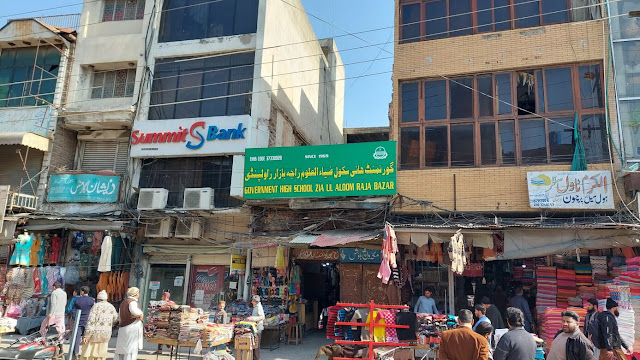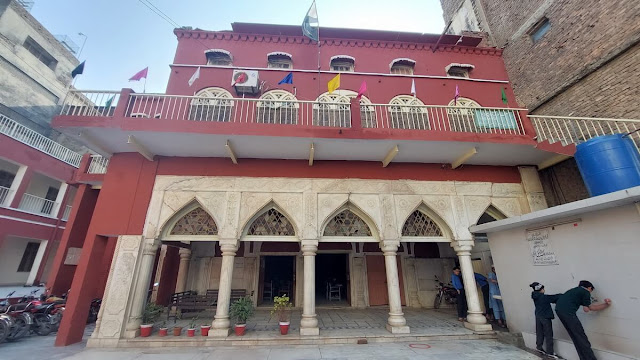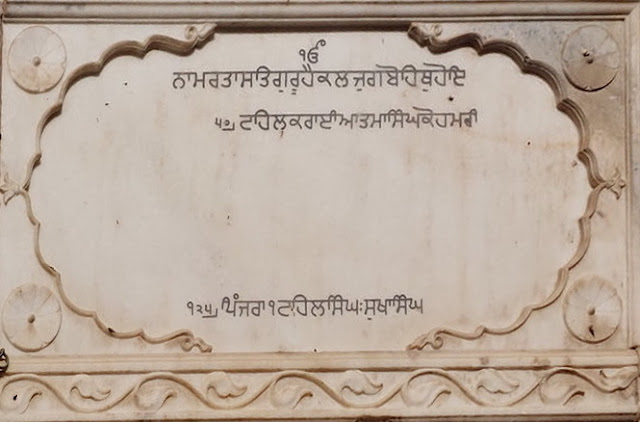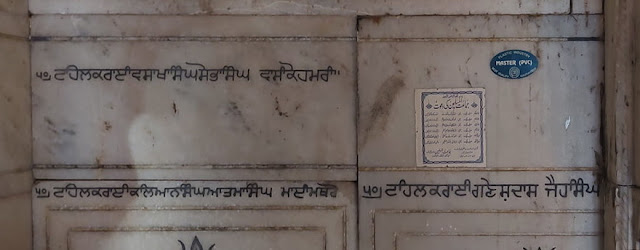In my previous article, I took you to the historic Gurdwara Narankari in Rawalpindi. In this article, we shall visit another prominent gurdwara of the city, Gurdwara Singh Sabha. It is located in Raja Bazar, one of the busiest areas of Rawalpindi. Today, a school named Zia-ul-Uloom for Boys operates in the building. The gurdwara stands at 33°36'54.6"N, 73°03'21.3"E.
The Singh Sabha Movement was launched in the 1870s to revive and restore the prestige of the Sikh faith, which many Sikhs felt had diminished after the fall of the Sikh kingdom in Punjab. At that time, conversions to other religions were on the rise, and proselytizing campaigns such as those of the Arya Samaj particularly targeted Sikh converts. The Sikh community, therefore, felt the urgent need to reaffirm and present their religion in its true and original form.
The first Singh Sabha conference was held in Amritsar in 1873. The movement gradually spread, and by the end of the 19th century, there were more than 100 branches across Punjab. Though it faced internal opposition from some Sikhs with differing views, the movement achieved remarkable success. Its greatest triumph came in 1925, when its followers regained control of Sikh gurdwaras from mahants and others who were not considered genuine adherents of the Sikh faith. (For more details, see Wikipedia.)
Today, the entrance to the gurdwara is almost hidden, tucked behind shops and a mosque. In fact, part of the mosque has extended into the premises of the gurdwara. Most of the original structures have not survived; in their place, new school rooms have been built. Yet, the main Darbar Hall still stands, silently narrating its past glory. The courtyard in front of the hall, however, is now covered with a modern concrete structure.

The main building, Darbar Hall. (25.01.2022.)
The beautiful veranda of Darbar Hall. (25.01.2022.)
Old wooden doors. (25.01.2022.)
The writer. (25.01.2022.)
੧ ਓ
ਸ੍ਰੀ ਗੁਰੂ ਸਿੰਘ ਸਭਾ ਰਾਵਲਪਿੰਡੀ
ਇਸ ਗੁਰਦਵਾਰੇ ਦਾ
ਬੁਨਿਅਦੀ ਪਥਰ
ਪੋਹ ਸੁਦੀ ਸਪਤਮੀ ਸੰ ਨਾਨਕ ਸ਼ਾਹੀ ੪੫੮
੩੦ ਦਿਸਮਬਰ ਸੰ ੧੯੨੭ ਪੋਹ ਦਿਨ ੧੬ ਸੰ ੧੯੮੪
ਸ਼੍ਰੀਮਾਨ ਸਸਰਦਾਰ ਮੋਹਨ ਸਿੰਘ ਜੀ ਰਈਸ
ਰਾਵਲਪਿੰਡੀ ਨੇ ਰਖਆ
اک اونکار
سری گرو سنگھ سبھا راولپنڈی
اس گوردوارے دا
بنیادی پتھر
پوہ سُدی سپتمی نانک شاہی 458
30 دسمبر 1927، 27 پوہ دن 14 سمت 1984
شریمان سردار موہن سنگھ جی رئیس
راولپنڈی نے رکھیا
Guru Singh Sabha
The cornerstone of this gurdwara was laid by Shriman Sardar Mohan Singh ji of Rawalpindi,
in 458 Nanak Shahi, Samvat Poh 14, 1984; 30 December, 1927 AD,
੧ ਓ
੧੦੦੦੦ ਸ੍ਰੀਮਤੀ ਮਾਈ ਕਰਤਾਰ ਦੇਈ ਜੀ ਨੇ
ਆਪਣੇ ਸਵਰਗਵਾਸੀ ਪਤੀ
ਚੌਧਰੀ ਕਰਮ ਸਿੰਘ ਜੀ ਸਿਆਲੀ ਦੀ ਯਾਦ
ਵਿਚ ਸ੍ਰੀ ਗੁਰੂ ਸਿੰਘ ਸਭਾ ਰਾਵਲਪਿੰਡੀ ਨੂਂ
ਅਰਦਾਸ ਕਰਾਈ ੧੨ ਅਗਸਤ ੧੯੨੭
اک اونکار
10000 روپے شریمتی مای کردار دئی جی نے
آپڑیں سورگباسی پتی
چودھری کرم سنگھ جی سیالی دی یاد
وچ سری گرو سنگھ سبھا راولپنڈی نوں
ارداس کرائی ، 12 اگست 1927
Rs10,000 Shrimati Mai Kartar Dayi, rendered service to Guru Singh Sabha, in the memory of his heavenly abode husband, Chaudhry Karam Singh ji Siali. On 12 August, 1927.
Darbar Hall. (25.01.2022.)
Prakash Asthan. (25.01.2022.)
Palki in the storeroom. (25.01.2022.)
A structure at the premises, known to be a Hindu temple. But probably a Smadhi. (25.01.2022.)
Entrance of the school. (25.01.2022.)
Once a vibrant hub of religious and social activity, this historic gurdwara has almost been lost to time and neglect. Today, few visitors make their way here, and those who do often return with a heavy heart. One cannot help but wish that we had preserved this and many other such places, not only for our neighbours across the border but also for our own future generations, so they could see how our past once was, and what lessons it still holds for the future.
Tariq Amir
February 14, 2022.
Islamabad




































